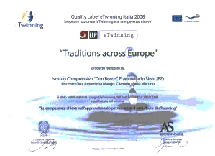In the past Sarmatians…
strongly valued social and family ties. Women were treated with honour and gallantry. Conversations were one of the favourite preoccupations. Guests were always welcomed – relatives, friends, even strangers, especially from abroad. Latin was widely spoken. Sumptuous feasts with large amount of alcohol were organised. Male quarrels and fighting during such events were quite common. At the parties the polonaise, mazurka, and oberek were the most popular dances. Honour was of prime relevance. Men lived longer than women, they also got married later. Marriage was described as ‘deep friendship’. Men often travelled a lot (to the Sejms, Sejmiki, indulgences, law courts, or common movements). Women stayed at home and took care of the property, livestock and children. Although large numbers of children were born, many of them died before reaching maturity. Girls and boys were brought up separately, either in the company of women or men. Suing, even for really irrelevant things was common, but in most cases a compromise was reached. (from http://en.wikipedia.org/wiki/Sarmatism)

What do we think about manners in the past and today?
I think in the past people had better mannners. For example, nobility and knights when they were fighting, they respected their rival. People also knew many foreign cute languages.
by Magda
In my opinion in the past women were treated in a different way and they behaved differently. They looked like ladies, behaved like ones so they were respected.
by Laura
In the past people had better mannners than now, e.g. they were more polite, they were greeting everyone, men kissed women’s hands and people had more respect for eleders. Today teenagers are vulgar and htey have no respect for others. They don’t want to study, they cheat and play truant. There is no toleration for people with other skin colours and religions, even disabled people are discriminated against.
by Kasia
In the past situation was better. People were obeying rules. Honour and nobility were the most important. It is great to read about nobles.
I think good manners are very important in our lives. You should treat everyone in a way that you want to be treated.
Nowadays people are becoming too confident. They think the world is theirs. They don’t care about others. Teenagers are trying to show their strength by being rude.
by Zuzia
In the past people (especially nobility) had different manners from ours. A noble was helpful and not prejudiced.
by Karolina
Nowadays people are not as tolerant or polite as they were in the past.
In the contemportary world people are different than in the past. Today’s teenagers don’t obey the rules. They are rude and nasty to other people.
Most of good manners are still appreciated, but presently people aren’t as polite and tolerant as in the past.
by Julia
In our granfathers’ times people were more polite, they were very helpful, even to strangers. In the 19th century in (Polish) houses children did the housework, they didn’t argue about it with their parents. They didn’t smoke, drink and weren’t sexually active at young age.
Teenage boys were really nice for girls, they treated them like ladies.
by Małgosia
class 3, Gimnazjum nr 18, Gdańsk, Poland


















Recent Comments